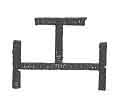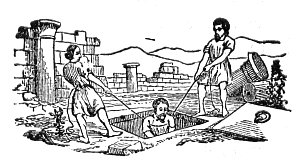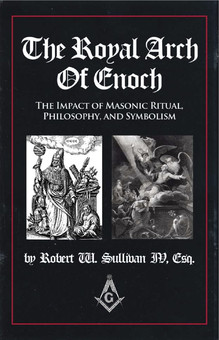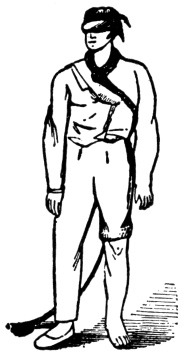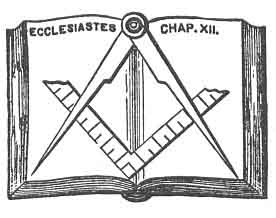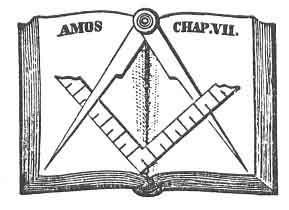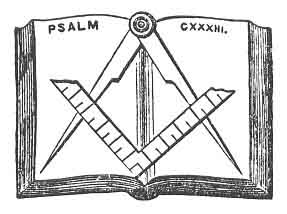Scribe repeats the same.
High Priest (to candidates.)–You now see that the world is indebted to Masonry for the preservation of this sacred volume. Had it not been for the wisdom and precaution of our ancient brethren, this, the only remaining copy of the law, would have been destroyed at the destruction of Jerusalem.1
p. 247
High Priest (taking a little pot out of the Ark.)–Companion King, what can this be? a pot of manna? We will read in the book of the law, and see what that says: (Reads, Exodus xvi. 32-34.)
“And Moses said, This is the thing which the Lord commandeth: Fill an omer of the manna to be kept for your generations, that they may see the bread wherewith I have fed you in the wilderness, when I brought you forth from the land of Egypt. And Moses said unto Aaron, Take a pot, and put an omer full of manna therein, and lay it up before the Lord, to be kept for your generations. As the Lord commanded Moses, so Aaron laid it up before the testimony, to be kept for a token.”
High Priest–A Pot of Manna! Holiness to the Lord!
King–A Pot of Manna! Holiness to the Lord!
Scribe repeats the same.
High Priest–Companions, we read in the book of the law, that he that overcometh, will I give to eat of the hidden manna. Come forward, Companions, you are entitled to it. (Each one receives a small lump of sugar.) But how it came deposited here, we cannot now particularly speak. You must go higher in Masonry before you can know.
The High Priest looks again into the Ark, and finds a stick with some buds upon it, which he shows to the King and Scribe, and after a consultation, they decide that it is Aaron’s Rod, and the fact is thus proclaimed in the same manner as the discovery of the manna.
High Priest then reads the following passage, Numbers xvii. 10:
“And the Lord said unto Moses, Bring Aaron’s rod again before the testimony, to be kept for a token.”
And also, Hebrews ix. 2-5:
“For there was a tabernacle made: the first, wherein was the candlesticks, and the table, and the shew-bread, which is called the sanctuary: and after the second veil, the tabernacle, which is called the Holiest of all; which had the golden censer, and the ark of the covenant, overlaid round about with gold; wherein was the golden pot that had manna; and Aaron’s rod, that budded, and the tables of the covenant; and over it the cherubim of glory, shadowing the mercy seat; of which we cannot now speak particularly.”
Looking again into the Ark, the High Priest takes out four pieces of paper, which he examines closely, consults with the
p. 248
[paragraph continues]King and Scribe, and then puts together, so as to show a key to the ineffable characters of this Degree:
KEY TO THE INEFFABLE CHARACTERS. The key to the ineffable characters, or Royal Arch Cipher, alluded to above, consists of right angles, in various situations, with the addition of a dot. By transposition, it forms twenty-six distinct characters, corresponding with the twenty-six letters of the English alphabet. There are two methods of combining these characters for secret correspondence: One method is to call the first sign,![]() , a; the second,
, a; the second,![]() , b; the third,
, b; the third,![]() , c; and so on, reading from left to right, thus:
, c; and so on, reading from left to right, thus:
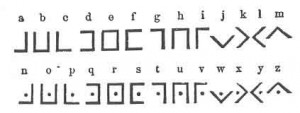 The second way to read the alphabet is as follows:
The second way to read the alphabet is as follows:
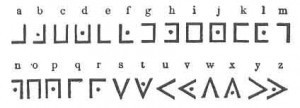 The upper left angle without a dot is a; the same with a dot is b, &c.
The upper left angle without a dot is a; the same with a dot is b, &c.
High Priest then reads Exodus vi. 2, 3:
“And God spake unto Moses, and said unto him, I am the Lord: and I appeared unto Abraham, unto Isaac, and unto Jacob, by the name of God Almighty; but by my name Jehovah was I not known to them.”

Moe is the founder of GnosticWarrior.com. He is a father, husband, author, martial arts black belt, and an expert in Gnosticism, the occult, and esotericism.


